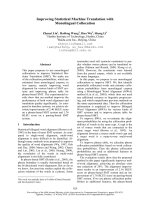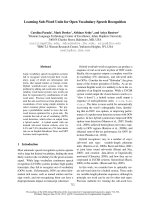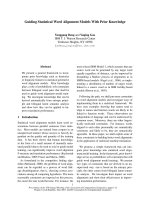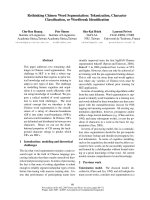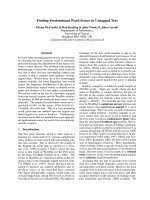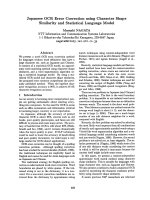Báo cáo khoa học: "Boosting Statistical Word Alignment Using Labeled and Unlabeled Data" ppt
Bạn đang xem bản rút gọn của tài liệu. Xem và tải ngay bản đầy đủ của tài liệu tại đây (92.75 KB, 8 trang )
Proceedings of the COLING/ACL 2006 Main Conference Poster Sessions, pages 913–920,
Sydney, July 2006.
c
2006 Association for Computational Linguistics
Boosting Statistical Word Alignment Using
Labeled and Unlabeled Data
Hua Wu Haifeng Wang Zhanyi Liu
Toshiba (China) Research and Development Center
5/F., Tower W2, Oriental Plaza, No.1, East Chang An Ave., Dong Cheng District
Beijing, 100738, China
{wuhua, wanghaifeng, liuzhanyi}@rdc.toshiba.com.cn
Abstract
This paper proposes a semi-supervised
boosting approach to improve statistical
word alignment with limited labeled data
and large amounts of unlabeled data. The
proposed approach modifies the super-
vised boosting algorithm to a semi-
supervised learning algorithm by incor-
porating the unlabeled data. In this algo-
rithm, we build a word aligner by using
both the labeled data and the unlabeled
data. Then we build a pseudo reference
set for the unlabeled data, and calculate
the error rate of each word aligner using
only the labeled data. Based on this semi-
supervised boosting algorithm, we inves-
tigate two boosting methods for word
alignment. In addition, we improve the
word alignment results by combining the
results of the two semi-supervised boost-
ing methods. Experimental results on
word alignment indicate that semi-
supervised boosting achieves relative er-
ror reductions of 28.29% and 19.52% as
compared with supervised boosting and
unsupervised boosting, respectively.
1 Introduction
Word alignment was first proposed as an inter-
mediate result of statistical machine translation
(Brown et al., 1993). In recent years, many re-
searchers build alignment links with bilingual
corpora (Wu, 1997; Och and Ney, 2003; Cherry
and Lin, 2003; Wu et al., 2005; Zhang and
Gildea, 2005). These methods unsupervisedly
train the alignment models with unlabeled data.
A question about word alignment is whether
we can further improve the performances of the
word aligners with available data and available
alignment models. One possible solution is to use
the boosting method (Freund and Schapire,
1996), which is one of the ensemble methods
(Dietterich, 2000). The underlying idea of boost-
ing is to combine simple "rules" to form an en-
semble such that the performance of the single
ensemble is improved. The AdaBoost (Adaptive
Boosting) algorithm by Freund and Schapire
(1996) was developed for supervised learning.
When it is applied to word alignment, it should
solve the problem of building a reference set for
the unlabeled data. Wu and Wang (2005) devel-
oped an unsupervised AdaBoost algorithm by
automatically building a pseudo reference set for
the unlabeled data to improve alignment results.
In fact, large amounts of unlabeled data are
available without difficulty, while labeled data is
costly to obtain. However, labeled data is valu-
able to improve performance of learners. Conse-
quently, semi-supervised learning, which com-
bines both labeled and unlabeled data, has been
applied to some NLP tasks such as word sense
disambiguation (Yarowsky, 1995; Pham et al.,
2005), classification (Blum and Mitchell, 1998;
Thorsten, 1999), clustering (Basu et al., 2004),
named entity classification (Collins and Singer,
1999), and parsing (Sarkar, 2001).
In this paper, we propose a semi-supervised
boosting method to improve statistical word
alignment with both limited labeled data and
large amounts of unlabeled data. The proposed
approach modifies the supervised AdaBoost al-
gorithm to a semi-supervised learning algorithm
by incorporating the unlabeled data. Therefore, it
should address the following three problems. The
first is to build a word alignment model with
both labeled and unlabeled data. In this paper,
with the labeled data, we build a supervised
model by directly estimating the parameters in
913
the model instead of using the Expectation
Maximization (EM) algorithm in Brown et al.
(1993). With the unlabeled data, we build an un-
supervised model by estimating the parameters
with the EM algorithm. Based on these two word
alignment models, an interpolated model is built
through linear interpolation. This interpolated
model is used as a learner in the semi-supervised
AdaBoost algorithm. The second is to build a
reference set for the unlabeled data. It is auto-
matically built with a modified "refined" combi-
nation method as described in Och and Ney
(2000). The third is to calculate the error rate on
each round. Although we build a reference set
for the unlabeled data, it still contains alignment
errors. Thus, we use the reference set of the la-
beled data instead of that of the entire training
data to calculate the error rate on each round.
With the interpolated model as a learner in the
semi-supervised AdaBoost algorithm, we inves-
tigate two boosting methods in this paper to im-
prove statistical word alignment. The first
method uses the unlabeled data only in the inter-
polated model. During training, it only changes
the distribution of the labeled data. The second
method changes the distribution of both the la-
beled data and the unlabeled data during training.
Experimental results show that both of these two
methods improve the performance of statistical
word alignment.
In addition, we combine the final results of the
above two semi-supervised boosting methods.
Experimental results indicate that this combina-
tion outperforms the unsupervised boosting
method as described in Wu and Wang (2005),
achieving a relative error rate reduction of
19.52%. And it also achieves a reduction of
28.29% as compared with the supervised boost-
ing method that only uses the labeled data.
The remainder of this paper is organized as
follows. Section 2 briefly introduces the statisti-
cal word alignment model. Section 3 describes
parameter estimation method using the labeled
data. Section 4 presents our semi-supervised
boosting method. Section 5 reports the experi-
mental results. Finally, we conclude in section 6.
2 Statistical Word Alignment Model
According to the IBM models (Brown et al.,
1993), the statistical word alignment model can
be generally represented as in equation (1).
∑
=
a'
e|f,a'
e|fa,
e|fa,
)Pr(
)Pr(
)Pr(
(1)
Where and
f
represent the source sentence
and the target sentence, respectively.
e
In this paper, we use a simplified IBM model
4 (Al-Onaizan et al., 1999), which is shown in
equation (2). This simplified version does not
take into account word classes as described in
Brown et al. (1993).
))))(()](([
))()](([(
)|( )|(
)Pr(
0,1
1
0,1
1
11
1
2
0
0
0
00
∏
∏
∏∏
≠=
>
≠=
==
−
−⋅≠
+−⋅=
⋅⋅
⋅
⎟
⎟
⎠
⎞
⎜
⎜
⎝
⎛
−
=
m
aj
j
m
aj
j
m
j
aj
l
i
ii
m
j
j
j
a
j
jpjdahj
cjdahj
eften
pp
m
ρ
φφ
φ
φ
φ
e|fa,
(2)
ml,
are the lengths of the source sentence and
the target sentence respectively.
j
is the position index of the target word.
j
a
is the position of the source word aligned to
the target word.
th
j
i
φ
is the number of target words that is
aligned to.
i
e
0
p , are the fertility probabilities for , and
1
p
0
e
1
10
=
+
pp .
)|
j
aj
et(f is the word translation probability.
)|(
ii
en
φ
is the fertility probability.
)(
1
j
a
cjd
ρ
−
is the distortion probability for the
head word of cept
1
i.
))((
1
jpjd
−
>
is the distortion probability for the
non-head words of cept i.
}:{min)(
k
k
aikih
=
=
is the head of cept i.
}:{max)(
kj
jk
aakjp
=
=
<
.
i
ρ
is the first word before with non-zero
i
e
fertility.
i
c is the center of cept i.
3 Parameter Estimation with Labeled
Data
With the labeled data, instead of using EM algo-
rithm, we directly estimate the three main pa-
rameters in model 4: translation probability, fer-
tility probability, and distortion probability.
1
A cept is defined as the set of target words connected to a source word
(Brown et al., 1993).
914
3.1 Translation Probability
Where
1),(
=
yx
δ
if y
x
=
. Otherwise, 0),(
=
yx
δ
.
The translation probability is estimated from the
labeled data as described in (3).
4 Boosting with Labeled Data and
Unlabeled Data
∑
=
'
)',(
),(
)|(
f
i
ji
ij
fecount
fecount
eft
(3)
In this section, we first propose a semi-
supervised AdaBoost algorithm for word align-
ment, which uses both the labeled data and the
unlabeled data. Based on the semi-supervised
algorithm, we describe two boosting methods for
word alignment. And then we develop a method
to combine the results of the two boosting meth-
ods.
Where is the occurring frequency of
aligned to in the labeled data.
),(
ji
fecount
i
e
j
f
3.2 Fertility Probability
The fertility probability )|(
ii
en
φ
describes the
distribution of the numbers of words that is
aligned to. It is estimated as described in (4).
i
e
4.1 Semi-Supervised AdaBoost Algorithm
for Word Alignment
∑
=
'
),'(
),(
)|(
φ
φ
φ
φ
i
ii
ii
ecount
ecount
en
(4)
Figure 1 shows the semi-supervised AdaBoost
algorithm for word alignment by using labeled
and unlabeled data. Compared with the super-
vised Adaboost algorithm, this semi-supervised
AdaBoost algorithm mainly has five differences.
Where
),(
ii
ecount
φ
describes the occurring fre-
quency of word aligned to
i
e
i
φ
target words in
the labeled data.
Word Alignment Model
0
p and describe the fertility probabilities
for . And and sum to 1. We estimate
directly from the labeled data, which is
shown in (5).
1
p
0
e
0
p
1
p
0
p
The first is the word alignment model, which
is taken as a learner in the boosting algorithm.
The word alignment model is built using both the
labeled data and the unlabeled data. With the
labeled data, we train a supervised model by di-
rectly estimating the parameters in the IBM
model as described in section 3. With the unla-
beled data, we train an unsupervised model using
the same EM algorithm in Brown et al. (1993).
Then we build an interpolation model by linearly
interpolating these two word alignment models,
which is shown in (8). This interpolated model is
used as the model described in figure 1.
l
M
Aligned
NullAligned
p
#
##
0
−
=
(5)
Where is the occurring frequency of
the target words that have counterparts in the
source language. is the occurring fre-
quency of the target words that have no counter-
parts in the source language.
Aligned#
Null#
3.3 Distortion Probability
)(Pr)1()(Pr
)Pr(
US
e|fa,e|fa,
e|fa,
⋅−+⋅=
λλ
(8)
There are two kinds of distortion probability in
model 4: one for head words and the other for
non-head words. Both of the distortion probabili-
ties describe the distribution of relative positions
Thus, if we let
i
cjj
ρ
−
=Δ
1
and )(
1
jpjj
−
=Δ
>
,
the distortion probabilities for head words and
non-head words are estimated in (6) and (7) with
the labeled data, respectively.
Where and are the
trained supervised model and unsupervised
model, respectively.
)(Pr
S
e|fa, )(Pr
U
e|fa,
λ
is an interpolation weight.
We train the weight in equation (8) in the same
way as described in Wu et al. (2005).
Pseudo Reference Set for Unlabeled Data
∑∑
∑
Δ
−Δ
−Δ
=Δ
'
1
'
'
'
,
''
1
,
1
11
),(
),(
)(
jcj
cj
i
i
i
i
cjj
cjj
jd
ρ
ρ
ρ
ρ
δ
δ
(6)
∑∑
∑
>
Δ
>
>
>>
−Δ
−Δ
=Δ
'
1
''
)(,
'''
1
)(,
1
11
))(,(
))(,(
)(
jjpj
jpj
jpjj
jpjj
jd
δ
δ
(7)
The second is the reference set for the unla-
beled data. For the unlabeled data, we automati-
cally build a pseudo reference set. In order to
build a reliable pseudo reference set, we perform
bi-directional word alignment on the training
data using the interpolated model trained on the
first round. Bi-directional word alignment in-
cludes alignment in two directions (source to
915
Input: A training set including
m
bilingual sentence pairs;
T
S
The reference set for the training data;
T
R
The reference sets and ( ) for the labeled data and the unlabeled
data respectively, where
L
R
U
R
TUL
, RRR ⊆
L
S
U
S
LUT
SSS ∪
=
and NULL
LU
=
∩
SS ;
A loop count L.
(1) Initialize the weights:
mimiw , ,1,/1)(
1
==
(2) For , execute steps (3) to (9).
L l to1=
(3) For each sentence pair i, normalize the
weights on the training set:
∑
==
j
lll
mijwiwip , ,1),(/)()(
(4) Update the word alignment model
based on the weighted training data.
l
M
(5) Perform word alignment on the training set
with the alignment model :
l
M
)(
lll
pMh =
(6) Calculate the error of with the reference
set :
l
h
L
R
∑
⋅=
i
ll
iip )()(
αε
Where
)(i
α
is calculated as in equation (9).
(7) If
2/1>
l
ε
, then let , and end the
training process.
1−= lL
(8) Let
)1/(
lll
ε
ε
β
−
=
.
(9) For all i, compute new weights:
nknkiwiw
lll
/))(()()(
1
β
⋅−
+
⋅
=
+
where, n represents n alignment links in
the i
th
sentence pair. k represents the num-
ber of error links as compared with .
T
R
Output: The final word alignment result for a source word
e
:
∑
=
⋅⋅==
L
l
ll
l
ff
fehfeWTfeRSeh
1
F
)),((),()
1
(logmaxarg),(maxarg)(
δ
β
Where
1),( =yx
δ
if y
x
= . Otherwise, 0),(
=
yx
δ
. is the weight of the alignment link
produced by the model , which is calculated as described in equation (10).
),( feWT
l
),( fe
l
M
Figure 1. The Semi-Supervised Adaboost Algorithm for Word Alignment
target and target to source) as described in Och
and Ney (2000). Thus, we get two sets of align-
ment results and on the unlabeled data.
Based on these two sets, we use a modified "re-
fined" method (Och and Ney, 2000) to construct
a pseudo reference set .
1
A
2
A
U
R
(1) The intersection is added to the
reference set .
21
AAI ∩=
U
R
(2) We add to if a) is satis-
fied or both b) and c) are satisfied.
21
) ,( AAfe ∪∈
U
R
a) Neither nor has an alignment in
and is greater than a threshold
e
f
U
R
)|( efp
1
δ
.
∑
=
'
)',(
),(
)|(
f
fecount
fecount
efp
Where is the occurring fre-
quency of the alignment link in
the bi-directional word alignment results.
),( fecount
) ,( fe
b) has a horizontal or a vertical
neighbor that is already in .
) ,( fe
U
R
c) The set does not contain
alignments with both horizontal and ver-
tical neighbors.
),(
U
feR ∪
Error of Word Aligner
The third is the calculation of the error of the
individual word aligner on each round. For word
alignment, a sentence pair is taken as a sample.
Thus, we calculate the error rate of each sentence
pair as described in (9), which is the same as de-
scribed in Wu and Wang (2005).
||||
||2
1)(
RW
RW
SS
SS
i
+
∩
−=
α
(9)
Where represents the set of alignment
links of a sentence pair i identified by the indi-
vidual interpolated model on each round. is
the reference alignment set for the sentence pair.
W
S
R
S
With the error rate of each sentence pair, we
calculate the error of the word aligner on each
round. Although we build a pseudo reference set
for the unlabeled data, it contains alignment
errors. Thus, the weighted sum of the error rates
of sentence pairs in the labeled data instead of
that in the entire training data is used as the error
of the word aligner.
U
R
916
Weights Update for Sentence Pairs
The forth is the weight update for sentence
pairs according to the error and the reference set.
In a sentence pair, there are usually several word
alignment links. Some are correct, and others
may be incorrect. Thus, we update the weights
according to the number of correct and incorrect
alignment links as compared with the reference
set, which is shown in step (9) in figure 1.
Weights for Word Alignment Links
The fifth is the weights used when we con-
struct the final ensemble. Besides the weight
)/1log(
l
β
, which is the confidence measure of
the word aligner, we also use the weight
to measure the confidence of each
alignment link produced by the model . The
weight is calculated as shown in (10).
Wu and Wang (2005) proved that adding this
weight improved the word alignment results.
th
l
),( feWT
l
l
M
),( feWT
l
∑∑
+
×
=
''
),'()',(
),(2
),(
ef
l
fecountfecount
fecount
feWT
(10)
Where is the occurring frequency
of the alignment link in the word align-
ment results of the training data produced by the
model .
),( fecount
) ,( fe
l
M
4.2 Method 1
This method only uses the labeled data as train-
ing data. According to the algorithm in figure 1,
we obtain and . Thus, we only
change the distribution of the labeled data. How-
ever, we build an unsupervised model using the
unlabeled data. On each round, we keep this un-
supervised model unchanged, and we rebuild the
supervised model by estimating the parameters
as described in section 3 with the weighted train-
ing data. Then we interpolate the supervised
model and the unsupervised model to obtain an
interpolated model as described in section 4.1.
The interpolated model is used as the alignment
model in figure 1. Thus, in this interpolated
model, we use both the labeled and unlabeled
data. On each round, we rebuild the interpolated
model using the rebuilt supervised model and the
unchanged unsupervised model. This interpo-
lated model is used to align the training data.
LT
SS =
LT
RR =
l
M
According to the reference set of the labeled
data, we calculate the error of the word aligner
on each round. According to the error and the
reference set, we update the weight of each sam-
ple in the labeled data.
4.3 Method 2
This method uses both the labeled data and the
unlabeled data as training data. Thus, we set
ULT
SSS ∪
=
and
ULT
RRR ∪
=
as described in
figure 1. With the labeled data, we build a super-
vised model, which is kept unchanged on each
round.
2
With the weighted samples in the train-
ing data, we rebuild the unsupervised model with
EM algorithm on each round. Based on these two
models, we built an interpolated model as de-
scribed in section 4.1. The interpolated model is
used as the alignment model in figure 1. On
each round, we rebuild the interpolated model
using the unchanged supervised model and the
rebuilt unsupervised model. Then the interpo-
lated model is used to align the training data.
l
M
Since the training data includes both labeled
and unlabeled data, we need to build a pseudo
reference set for the unlabeled data using the
method described in section 4.1. According to
the reference set of the labeled data, we cal-
culate the error of the word aligner on each
round. Then, according to the pseudo reference
set and the reference set , we update the
weight of each sentence pair in the unlabeled
data and in the labeled data, respectively.
U
R
L
R
U
R
L
R
There are four main differences between
Method 2 and Method 1.
(1) On each round, Method 2 changes the distri-
bution of both the labeled data and the unla-
beled data, while Method 1 only changes the
distribution of the labeled data.
(2) Method 2 rebuilds the unsupervised model,
while Method 1 rebuilds the supervised
model.
(3) Method 2 uses the labeled data instead of the
entire training data to estimate the error of
the word aligner on each round.
(4) Method 2 uses an automatically built pseudo
reference set to update the weights for the
sentence pairs in the unlabeled data.
4.4 Combination
In the above two sections, we described two
semi-supervised boosting methods for word
alignment. Although we use interpolated models
2
In fact, we can also rebuild the supervised model accord-
ing to the weighted labeled data. In this case, as we know,
the error of the supervised model increases. Thus, we keep
the supervised model unchanged in this method.
917
for word alignment in both Method 1 and
Method 2, the interpolated models are trained
with different weighted data. Thus, they perform
differently on word alignment. In order to further
improve the word alignment results, we combine
the results of the above two methods as described
in (11).
)),(),((maxarg
)(
2211
F3,
feRSfeRS
eh
f
⋅+⋅=
λλ
ods to calculate the precision, recall, f-measure,
and alignment error rate (AER) are shown in
equations (12), (13), (14), and (15). It can be
seen that the higher the f-measure is, the lower
the alignment error rate is.
|S|
|SS|
G
CG
∩
=precision
(12)
|S|
|SS|
C
CG
∩
=recall
(11)
(13)
||||
||2
CG
CG
SS
SS
fmeasure
+
∩×
=
Where is the combined hypothesis for
word alignment. and are the
two ensemble results as shown in figure 1 for
Method 1 and Method 2, respectively.
)(
F3,
eh
),(
1
feRS ),(
2
feRS
1
λ
and
2
λ
are the constant weights.
(14)
fmeasure
SS
SS
AER −=
+
∩×
−= 1
||||
||2
1
CG
CG
(15)
5.3 Experimental Results
5 Experiments
With the data in section 5.1, we get the word
alignment results shown in table 2. For all of the
methods in this table, we perform bi-directional
(source to target and target to source) word
alignment, and obtain two alignment results on
the testing set. Based on the two results, we get
the "refined" combination as described in Och
and Ney (2000). Thus, the results in table 2 are
those of the "refined" combination. For EM
training, we use the GIZA++ toolkit
4
.
In this paper, we take English to Chinese word
alignment as a case study.
5.1 Data
We have two kinds of training data from general
domain: Labeled Data (LD) and Unlabeled Data
(UD). The Chinese sentences in the data are
automatically segmented into words. The statis-
tics for the data is shown in Table 1. The labeled
data is manually word aligned, including 156,421
alignment links.
Data
# Sentence
Pairs
# English
Words
Results of Supervised Methods
Using the labeled data, we use two methods to
estimate the parameters in IBM model 4: one is
to use the EM algorithm, and the other is to esti-
mate the parameters directly from the labeled
data as described in section 3. In table 2, the
method "Labeled+EM" estimates the parameters
with the EM algorithm, which is an unsupervised
method without boosting. And the method "La-
beled+Direct" estimates the parameters directly
from the labeled data, which is a supervised
method without boosting. "Labeled+EM+Boost"
and "Labeled+Direct+Boost" represent the two
supervised boosting methods for the above two
parameter estimation methods.
# Chinese
Words
LD 31,069 255,504 302,470
UD 329,350 4,682,103 4,480,034
Table 1. Statistics for Training Data
We use 1,000 sentence pairs as testing set,
which are not included in LD or UD. The testing
set is also manually word aligned, including
8,634 alignment links in the testing set
3
.
5.2 Evaluation Metrics
We use the same evaluation metrics as described
in Wu et al. (2005), which is similar to those in
(Och and Ney, 2000). The difference lies in that
Wu et al. (2005) take all alignment links as sure
links.
Our methods that directly estimate parameters
in IBM model 4 are better than that using the EM
algorithm. "Labeled+Direct" is better than "La-
beled+EM", achieving a relative error rate reduc-
tion of 22.97%. And "Labeled+Direct+Boost" is
better than "Labeled+EM+Boost", achieving a
relative error rate reduction of 22.98%. In addi-
tion, the two boosting methods perform better
than their corresponding methods without
If we use to represent the set of alignment
links identified by the proposed method and
to denote the reference alignment set, the meth-
G
S
C
S
3
For a non one-to-one link, if m source words are aligned to
n target words, we take it as one alignment link instead of
m∗n alignment links.
4
It is located at GIZA++.html.
918
Method Precision Recall F-Measure AER
Labeled+EM 0.6588 0.5210 0.5819 0.4181
Labeled+Direct 0.7269 0.6609 0.6924 0.3076
Labeled+EM+Boost 0.7384 0.5651 0.6402 0.3598
Labeled+Direct+Boost 0.7771 0.6757 0.7229 0.2771
Unlabeled+EM 0.7485 0.6667 0.7052 0.2948
Unlabeled+EM+Boost 0.8056 0.7070 0.7531 0.2469
Interpolated 0.7555 0.7084 0.7312 0.2688
Method 1 0.7986 0.7197 0.7571 0.2429
Method 2 0.8060 0.7388 0.7709 0.2291
Combination 0.8175 0.7858 0.8013 0.1987
Table 2. Word Alignment Results
boosting. For example, "Labeled+Direct+Boost"
achieves an error rate reduction of 9.92% as
compared with "Labeled+Direct".
Results of Unsupervised Methods
With the unlabeled data, we use the EM algo-
rithm to estimate the parameters in the model.
The method "Unlabeled+EM" represents an un-
supervised method without boosting. And the
method "Unlabeled+EM+Boost" uses the same
unsupervised Adaboost algorithm as described in
Wu and Wang (2005).
The boosting method "Unlabeled+EM+Boost"
achieves a relative error rate reduction of 16.25%
as compared with "Unlabeled+EM". In addition,
the unsupervised boosting method "Unla-
beled+EM+Boost" performs better than the su-
pervised boosting method "Labeled+Direct+
Boost", achieving an error rate reduction of
10.90%. This is because the size of labeled data
is too small to subject to data sparseness problem.
Results of Semi-Supervised Methods
By using both the labeled and the unlabeled
data, we interpolate the models trained by "La-
beled+Direct" and "Unlabeled+EM" to get an
interpolated model. Here, we use "interpolated"
to represent it. "Method 1" and "Method 2" rep-
resent the semi-supervised boosting methods de-
scribed in section 4.2 and section 4.3, respec-
tively. "Combination" denotes the method de-
scribed in section 4.4, which combines "Method
1" and "Method 2". Both of the weights
1
λ
and
2
λ
in equation (11) are set to 0.5.
"Interpolated" performs better than the meth-
ods using only labeled data or unlabeled data. It
achieves relative error rate reductions of 12.61%
and 8.82% as compared with "Labeled+Direct"
and "Unlabeled+EM", respectively.
Using an interpolation model, the two semi-
supervised boosting methods "Method 1" and
"Method 2" outperform the supervised boosting
method "Labeled+Direct+Boost", achieving a
relative error rate reduction of 12.34% and
17.32% respectively. In addition, the two semi-
supervised boosting methods perform better than
the unsupervised boosting method "Unlabeled+
EM+Boost". "Method 1" performs slightly better
than "Unlabeled+EM+Boost". This is because
we only change the distribution of the labeled
data in "Method 1". "Method 2" achieves an er-
ror rate reduction of 7.77% as compared with
"Unlabeled+EM+Boost". This is because we use
the interpolated model in our semi-supervised
boosting method, while "Unlabeled+EM+Boost"
only uses the unsupervised model.
Moreover, the combination of the two semi-
supervised boosting methods further improves
the results, achieving relative error rate reduc-
tions of 18.20% and 13.27% as compared with
"Method 1" and "Method 2", respectively. It also
outperforms both the supervised boosting
method "Labeled+Direct+Boost" and the unsu-
pervised boosting method "Unlabeled+EM+
Boost", achieving relative error rate reductions of
28.29% and 19.52% respectively.
Summary of the Results
From the above result, it can be seen that all
boosting methods perform better than their corre-
sponding methods without boosting. The semi-
supervised boosting methods outperform the su-
pervised boosting method and the unsupervised
boosting method.
6 Conclusion and Future Work
This paper proposed a semi-supervised boosting
algorithm to improve statistical word alignment
with limited labeled data and large amounts of
unlabeled data. In this algorithm, we built an in-
terpolated model by using both the labeled data
919
and the unlabeled data. This interpolated model
was employed as a learner in the algorithm. Then,
we automatically built a pseudo reference for the
unlabeled data, and calculated the error rate of
each word aligner with the labeled data. Based
on this algorithm, we investigated two methods
for word alignment. In addition, we developed a
method to combine the results of the above two
semi-supervised boosting methods.
Experimental results indicate that our semi-
supervised boosting method outperforms the un-
supervised boosting method as described in Wu
and Wang (2005), achieving a relative error rate
reduction of 19.52%. And it also outperforms the
supervised boosting method that only uses the
labeled data, achieving a relative error rate re-
duction of 28.29%. Experimental results also
show that all boosting methods outperform their
corresponding methods without boosting.
In the future, we will evaluate our method
with an available standard testing set. And we
will also evaluate the word alignment results in a
machine translation system, to examine whether
lower word alignment error rate will result in
higher translation accuracy.
References
Yaser Al-Onaizan, Jan Curin, Michael Jahr, Kevin
Knight, John Lafferty, Dan Melamed, Franz-Josef
Och, David Purdy, Noah A. Smith, and David
Yarowsky. 1999. Statistical Machine Translation
Final Report. Johns Hopkins University Workshop.
Sugato Basu, Mikhail Bilenko, and Raymond J.
Mooney. 2004. Probabilistic Framework for Semi-
Supervised Clustering. In Proc. of the 10
th
ACM
SIGKDD International Conference on Knowledge
Discovery and Data Mining (KDD-2004), pages
59-68.
Avrim Blum and Tom Mitchell. 1998. Combing La-
beled and Unlabeled Data with Co-training. In
Proc. of the 11
th
Conference on Computational
Learning Theory (COLT-1998), pages1-10.
Peter F. Brown, Stephen A. Della Pietra, Vincent J.
Della Pietra, and Robert L. Mercer. 1993. The
Mathematics of Statistical Machine Translation:
Parameter Estimation. Computational Linguistics,
19(2): 263-311.
Colin Cherry and Dekang Lin. 2003. A Probability
Model to Improve Word Alignment. In Proc. of the
41
st
Annual Meeting of the Association for Compu-
tational Linguistics (ACL-2003), pages 88-95.
Michael Collins and Yoram Singer. 1999. Unsuper-
vised Models for Named Entity Classification. In
Proc. of the Joint SIGDAT Conference on Empiri-
cal Methods in Natural Language Processing and
Very Large Corpora (EMNLP/VLC-1999), pages
100-110.
Thomas G. Dietterich. 2000. Ensemble Methods in
Machine Learning. In Proc. of the First Interna-
tional Workshop on Multiple Classifier Systems
(MCS-2000), pages 1-15.
Yoav Freund and Robert E. Schapire. 1996. Experi-
ments with a New Boosting Algorithm. In Proc. of
the 13
th
International Conference on Machine
Learning (ICML-1996), pages 148-156.
Franz Josef Och and Hermann Ney. 2000. Improved
Statistical Alignment Models. In Proc. of the 38
th
Annual Meeting of the Association for Computa-
tional Linguistics (ACL-2000), pages 440-447.
Franz Josef Och and Hermann Ney. 2003. A System-
atic Comparison of Various Statistical Alignment
Models. Computational Linguistics, 29(1):19-51.
Thanh Phong Pham, Hwee Tou Ng, and Wee Sun Lee
2005. Word Sense Disambiguation with Semi-
Supervised Learning. In Proc. of the 20th National
Conference on Artificial Intelligence (AAAI 2005),
pages 1093-1098.
Anoop Sarkar. 2001. Applying Co-Training Methods
to Statistical Parsing. In Proc. of the 2
nd
Meeting of
the North American Association for Computational
Linguistics( NAACL-2001), pages 175-182.
Joachims Thorsten. 1999. Transductive Inference for
Text Classification Using Support Vector Ma-
chines. In Proc. of the 16
th
International Confer-
ence on Machine Learning (ICML-1999), pages
200-209.
Dekai Wu. 1997. Stochastic Inversion Transduction
Grammars and Bilingual Parsing of Parallel Cor-
pora. Computational Linguistics, 23(3): 377-403.
Hua Wu and Haifeng Wang. 2005. Boosting Statisti-
cal Word Alignment. In Proc. of the 10
th
Machine
Translation Summit, pages 313-320.
Hua Wu, Haifeng Wang, and Zhanyi Liu. 2005.
Alignment Model Adaptation for Domain-Specific
Word Alignment. In Proc. of the 43
rd
Annual Meet-
ing of the Association for Computational Linguis-
tics (ACL-2005), pages 467-474.
David Yarowsky. 1995. Unsupervised Word Sense
Disambiguation Rivaling Supervised Methods. In
Proc. of the 33
rd
Annual Meeting of the Association
for Computational Linguistics (ACL-1995), pages
189-196.
Hao Zhang and Daniel Gildea. 2005. Stochastic Lexi-
calized Inversion Transduction Grammar for
Alignment. In Proc. of the 43
rd
Annual Meeting of
the Association for Computational Linguistics
(ACL-2005), pages 475-482.
920

